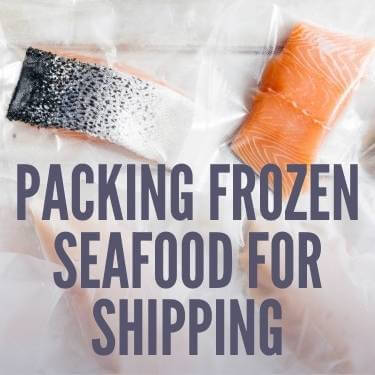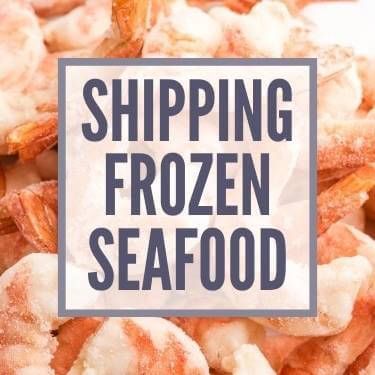There are few things in the food world that spoil faster than seafood. Protein that comes from bodies of water have notoriously short shelf lives — unless they are properly frozen and shipped. But it’s hard to know what that really means, and it’s not an easy mindframe to be in if you’ve never had to undergo shipping frozen seafood before.
Even for a first-timer, it doesn’t have to be overly difficult. If you take care in properly packaging the meat, and strictly following procedures to maintain the cold chain during shipping and storage, you’ll be in great shape while shipping frozen seafood to all parts of the U.S.
Read on for full descriptions of how to accomplish this.

Whether it’s king crab, sea bass, lobster tails or some other type of fresh seafood, knowing how to successfully freight ship the various forms of animal protein is of paramount importance. This is more complicated than shipping frozen food of other varieties. Whether seafood is fresh or frozen, it is naturally very perishable and that process is amplified if it is not handled correctly at every step.
Once the fresh fish is caught, processed and then frozen, a huge factor in keeping it in optimal condition for resale is how you package it. Different types of seafood might be packed a little different but all have the prevailing theme that an insulated container and optionally using ice can help it stay frozen during the duration of the trip.
Besides being insulated, the boxes or containers should also be sturdy so the seafood being transported doesn’t become damaged. In some cases, you can use additional refrigerants such as gel packs, ice packs or dry ice to make sure the shipment stays frozen.
Even before the actual packaging stage, you want to follow strict guidelines for handling seafood in rinsing it and maintaining best practices to avoid contamination before freezing the fish or shellfish.
We understand shipping fresh fish, along with the seafood supply chain. See how a strategic partner can help your fresh catch get to market.

The most important thing about shipping frozen seafood is maintaining the cold chain at all times. This refers to the point once the seafood is frozen and means that the supplier, shipper and retailer should all do everything in their power to keep the product frozen at all times.
This means a refrigerated truck that can be set to freezing is essential. Seafood can easily spoil and become unsafe once it begins to thaw during transport. Since you’re trying to keep this future food as fresh, safe and delicious for as long as possible, great care needs to be taken in this area.
Whether seafood is fresh or frozen, once it is caught, the clock starts ticking on when it should be consumed. In fact, whether seafood is frozen or not, most shipments are completed in a transit time of 24 hours or less. This means overnight shipping might be required to maintain your shipment’s quality.
For that reason, you should heavily consider not only refrigerated shipping but expedited shipping as well. Expedited shipping is a service many third-party logistics (3PL) offer to speed up a shipment so it arrives earlier than a standard delivery timeline. Depending on the length for the journey, this can shave an entire day or two off the trip’s total length. However, shipping costs will rise if using expedited shipping.
When dealing with the volatility of shipping seafood, the additional expense of expedited shipping could very well be a worthy investment to help ensure that your food transport arrives more quickly and theoretically at a higher level of freshness.
Expounding on the earlier point of not breaking the cold chain, the best way to make sure it is not broken is this:
While a completely frozen shipment of seafood being outside of a freezer for 5 minutes might not compromise its integrity, the cold chain should be strictly adhered to.
Are you transporting blue crab from the Chesapeake Bay? See how the right freight partner can make the process simple.
Shipping frozen seafood can be a challenge because of the extreme perishability of the product. So even though you’ve acquired some good knowledge of the process, the next step is to entrust your seafood shipments to R+L Global Logistics. We are experts in handling this kind of transportation for our business partners and will make sure your customers are receiving high-quality, frozen seafood on your behalf.
Starting off, you’ll absolutely need to use refrigerated shipping to make the journey and R+L Global Logistics has plenty of reefer carriers at its disposal. We have knowledgeable drivers who know how to handle freight that needs to remain frozen for the duration of the entire shipment. You won’t have to worry about your fish thawing out under our watch.
Moving on, there might be times when having a refrigerated truck isn’t enough. You can also opt for expedited shipping, which can cut valuable time in transit off of your load and give you much better peace of mind that your frozen seafood will still be at its peak when it reaches grocery stores. While there is an additional cost, it very well might be worth it when time is of the essence.
We offer industry-leading customer service, a 99.5 percent on-time delivery rate to meet your delivery date and real-time freight visibility with every load to help make you secure that we care about you as a customer. So when you’re ready to start shipping seafood, give R+L Global Logistics a call at 866.353.7178 for a free shipping quote and to see how we can make a difference for your business.
R+L Global Logistics
315 NE 14th St., Ocala, FL 34470